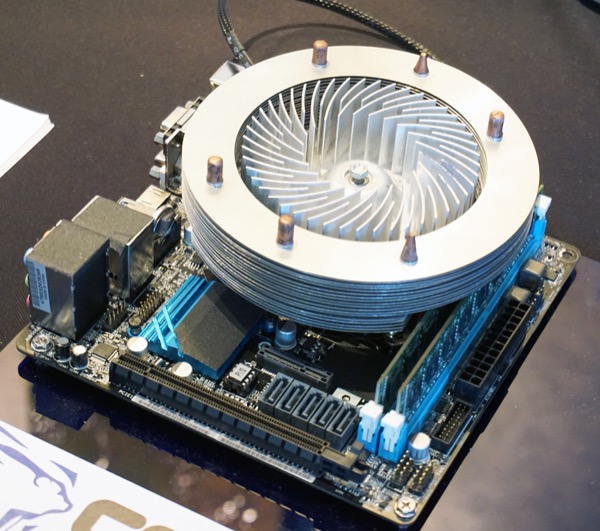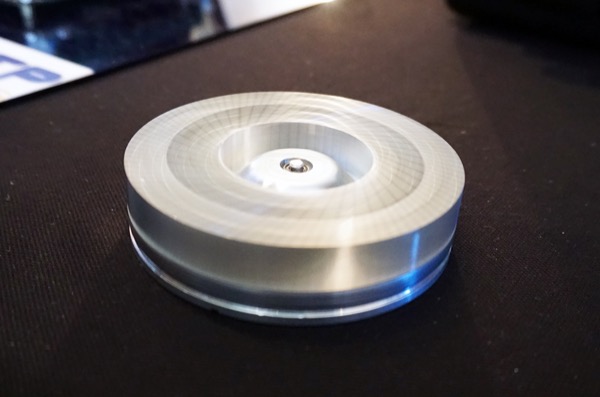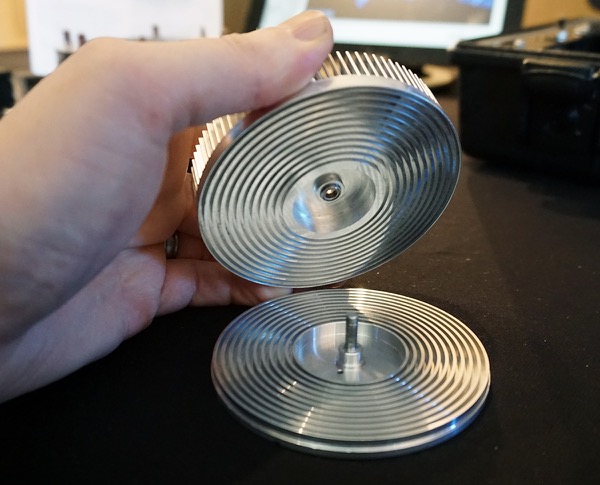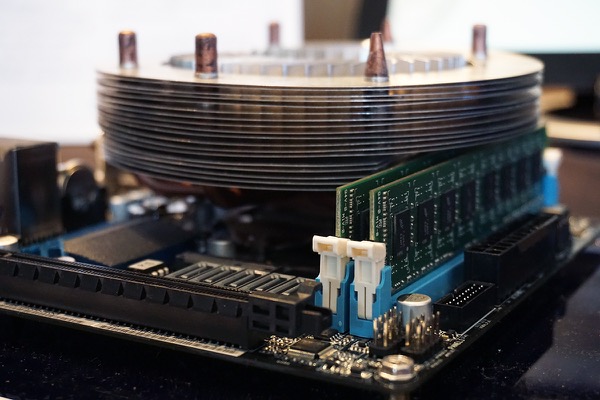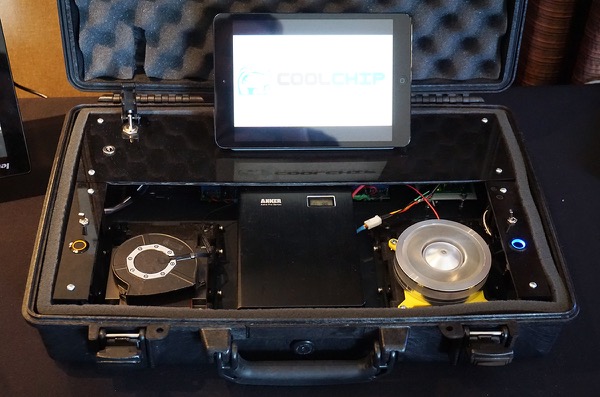CoolChip Technologies Demos Innovative All-Aluminum Heatsink-And-Fan CPU Cooler Design
In addition to the firehose of new products we see at CES, we're also privy to some new technologies that are under development. CoolChip Technologies, a startup that recently forged a partnership with Cooler Master, showed off a CPU cooler technology that it calls "kinetic cooling."
Essentially, the company makes an all-aluminum cooler that functions as both heatsink and fan. Instead of the typical copper heatpipes and plastic fan design, CoolChip's two-piece prototypes consist of a metal plate that rests on the CPU and a metal fan assembly with vertically oriented fins on top. A smooth bearing allows the top piece to spin freely, and it connects to a motherboard's fan pins, just like a typical fan.
Both pieces have a ringed design, and although it's hard to see it from the images, the rings are actually offset. This is a brilliant little bit of design, because it essentially allows the two pieces to "touch" without actually touching, and it creates pockets of air in the rings. As that air heats up, the fan pulls it up, then blows it out.
Because the fan is built of metal fins, the fan itself also doubles as a heatsink. CoolChip admitted that this fan can't (or at least, currently doesn't) push the same CFM as a traditional fan, but the metal fan-as-heatsink design makes up for it. The full cooler employs a set of passive metal rings that also helps with heat dissipation.
Furthermore, the design allows for a lower-profile cooler, which should entice plenty of builders who are always looking for creative ways to create more space inside a chassis.
CoolChip had a demo system running the kinetic cooler (which does not yet have an official name), and although I couldn't say with certainty that the result was 0 dB, it was close enough.
Obviously, with a design like this, the quality of the fan bearing is of utmost importance. On that point, unfortunately, CoolChip hasn't decided for certain which bearing, or even which type of bearing the final product will use. The team has considered fluid bearings, but they may simply end up using standard fan bearings.
Get Tom's Hardware's best news and in-depth reviews, straight to your inbox.
Even with an impressive demo, I was concerned that the weight of the aluminum fan could wear out the bearing prematurely. CoolChip, on the other hand, was not concerned on that point, and the team fairly noted that unlike thin plastic fan blades that can warp over time and cause noise issues, this metal assembly will have no such problems.
The reps also said that the prototypes they've been using for months now have had no issues with worn out bearings. Even so, it's something to be aware of, and I suspect it's a reason why the company hasn't finalized the bearing yet.
A notable bit of history on this unique cooler is that CoolChip originally intended it for use in the enterprise, but after gaining no traction there, the company eventually refocused its efforts on the enthusiast space, finding a partner in Cooler Master.
In fact, CoolChip's CES demo is in Cooler Master's suite, and that's because Cooler Master is actually the OEM making the prototype kinetic coolers. When the devices eventually hit the market sometime this year (we expect "sometime" to be Computex), Cooler Master will also make the final products.
Update, 9:40am Jan 16, 2015: Because several commenters have asked, we reached out to CoolChip to clarify its relationship with Sandia. A representative told us, "We have a licensing agreement for commercialization with Sandia’s Licensing and Technology Transfer group. In keeping with Sandia’s vision to be the nation's premier science and engineering laboratory for national security and technology innovation, CoolChip is one of many companies that have licensing agreements with Sandia."
Follow Seth Colaner @SethColaner. Follow us @tomshardware, on Facebook and on Google+.
Seth Colaner previously served as News Director at Tom's Hardware. He covered technology news, focusing on keyboards, virtual reality, and wearables.
-
DarkSable Finally!Reply
I've been waiting for a LONG time for somebody to look at the Sandia Cooler and decide that it was a design worth playing with.
Can't wait to see benchmarks of CoolChip's take on this... on first impression, I question how well it will dissipate heat; and then I think about the fact that it's not my field and that they must have a few tricks up their sleeve.
If this kind of cooler really can make the huge size / cooling improvements that it claims to, then it's replacing custom watercooling in my mini ITX rig to downsize it even further. -
cypeq There is a reason why enterprise didn't go for this solution... it wasn't any better than fans. This design looks cool but the transition of heat through air is just very efficient.Reply
Air is actually better at isolating from heat than for transporting of it so you can't expect that fan-sink to do much of heat disposal.
Also fans are cheep and light this improves bearing life while this design will require much more durable bearing because of heavier object. -
David Dewis I actually am looking forward to this. Theoretically, they shouldn't be expensive to produce or sell. I love this kind of scientific based, cutting edge stuff. Just want to see actual benchmarks on real world scenarios now.Reply -
f-14 i like how to stock intel heat sink has been recycled! i like the fan, don't care for the sink as it exhausts too much heat back into the case. i would like to see a revival of the coolermaster jet 7 with a bit more fine tuning to exhaust shroud so heat goes one direction thru the heat sink and out to the rear case exhaust fan. the jet 7's direct air flow to the center and entire heatsink was a very good solution. i can think of several ways to make this happen and one even with an offset built into the heatsink for the fan. i'm not big on axial fans and much more prefer radial fans.Reply
the main problem i have with this particular solution from coolchip is how well does it work at a vertical set up which is what leads me to perceive is the hold up on the bearing. it's not like shimano doesn't have the bearing solution already, and heck if you could recycle your abec3-5-7- bearing from your roller blades that would be great also with a drop in replacement bearing solution or something you have to drip a drop or 3 of veggie oil into every year ( you know when you are cleaning out the dust bunnies anyways) -
knowom I have to wonder why the aluminum fan blade portion of it doesn't use any heat pipes like a ring all the way around the center of it or a few U shaped ones to expel the heat up and away more rapidly. I'm also curious about it's effective efficiency compare to other traditional tower coolers because that's important. It does sound promising like it might wins points on quietness though if the 0db claim is accurate depending on just how close to 0db it really is if it's under 10db that's pretty good..Reply -
DatGameh PURE COPYCAT OF THE SANDIA CPU COOLERReply
www.frostytech.com/articleview.cfm?articleID=2722
The Sandia cooler was introduced during 2012.
This is a lawsuit in the making. -
DarkSable Reply15010537 said:PURE COPYCAT OF THE SANDIA CPU COOLER
www.frostytech.com/articleview.cfm?articleID=2722
The Sandia cooler was introduced during 2012.
This is a lawsuit in the making.
...which some of us have already said.
Anyways, there are two issues here:
1) The Sandia cooler, as much as we want it to be a real product, does not exist. You can't buy one, you can't put one in your computer.
2) How do you know that this isn't licenced out? The Sandia cooler was never meant to be a product, it was made by research labs for a large company. -
DarkSable Reply15004553 said:There is a reason why enterprise didn't go for this solution... it wasn't any better than fans. This design looks cool but the transition of heat through air is just very efficient.
Air is actually better at isolating from heat than for transporting of it so you can't expect that fan-sink to do much of heat disposal.
Also fans are cheep and light this improves bearing life while this design will require much more durable bearing because of heavier object.
Fair point on the bearing, though the original Sandia cooler uses an air bearing... which is a MUCH more elegant design.
As for claiming that enterprise companies don't use this because it's not a good cooler? Give me a break.. and do a little reading on the Sandia cooler. It's many, many times more efficient than anything we have right now, due to some rather interesting properties of liquid dynamics.
Enterprise solutions don't care about what's efficient... they care about what's CHEAP. A system with a nickle block and a single fan pulling air into the front of the computer is the cheapest solution that cools everything within tolerance levels... why would they spend more money on experimental tech?
Oh, and @MJW: It should work no matter what orientation the cooler is at. At least, the original Sandia cooler does. I read about this thing several years ago and have been waiting to see it come to market - I'm rather excited about this.
